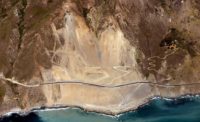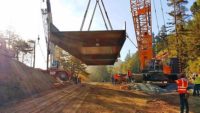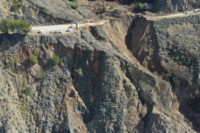Work continues to stabilize Highway 1 in Big Sur along the coast of California, where a chunk of the lane along the cliff collapsed into the Pacific Ocean March 30 after a rainstorm. Engineers are discussing a permanent fix, with a viaduct as the likely solution.
The famed stretch of the Pacific Coast Highway has been closed to all but convoy traffic in the Rocky Creek area, about 13 miles south of Carmel-by-the-Sea. Caltrans hired Teichert Construction for the temporary stabilization, which involves drilling, installing and grouting vertical rock dowels through the southbound lane pavement adjacent to the existing west edge of the roadway. Once horizontal reinforcing dowels also are in place, crews will install reinforced shotcrete in the vertical face of the repair to help stabilize the roadway.
The temporary fix is budgeted at $9.4 million and Caltrans anticipates completion by Memorial Day, which will open up the highway to alternating one-way traffic using 24/7 signalized traffic control.
“The important milestone there is that we'll be able to open up to anybody 24/7,” says Kevin Drabinski, a spokesperson for Caltrans District 5. The current twice-a-day convoys are limited to essential workers and residents, making the coastline south of Rocky Creek inaccessible to tourists.
The estimated price tag for the permanent repair is $17.3 million, bringing the total cost of reconstructing the highway to $26.7 million.
Viaduct a Possibility
Engineers have started meeting to discuss the permanent fix. “A viaduct is the [solution] that would seem to fit at this time, but we've made no final decision on it,” says Drabinski.
Other possibilities include building a bridge or wall, but after a similar slip-out in the Rocky Creek area shut down Highway 1 in March 2011, the state opted for a viaduct. Construction did not begin on the $11-million project until September 2012 and was completed in November 2013.
“We can maybe borrow some ideas off of that [project],” Drabinski says. “In that case, there was a little bit more space to work with, a little more of a flat area on the inland side as opposed to the steeper slope" at the site of the current slip-out," he adds. "We have to see, given these specific safety issues, what would work.”
With the Rocky Creek slip-out, Highway 1 in Big Sur is now closed at four points, dealing a blow to tourism. Caltrans is still working on clearing the massive Paul’s Slide in southern Monterey County, which has cut off northbound access to Big Sur from San Luis Obispo County since January 2023.
Another landslide, which happened in May 2017, also was caused by heavy rains. It dropped about 6 million cu yd of dirt on the roadway, displacing 50 acres of road and creating 16 acres of new California coastline. A $54-million repair job, involving 200,000 tons of riprap, reopened the highway the following year.
In 2021, rainfall washed out a 150-ft-long section of the highway, requiring an $11.5-million emergency repair contract. That repair entailed enhanced fill and a new drainage system of culverts.
Geological Instability
The continuing geological instability has caused speculation as to whether the road repairs are an exercise in futility. But Drabinski notes that there are thousands of residents, businesses and schools that depend on the road. Moreover, Caltrans is making “advances in engineering, so that we're more knowledgeable about the kinds of responses we can make to the challenges on the coast.
“There's a healthy body of knowledge and history about working on the coast and about anticipating what could happen in specific locations that you're able to use to your advantage and allows you to prepare better before winter,” Drabinski adds. “It allows you to respond better to these events.”





Post a comment to this article
Report Abusive Comment